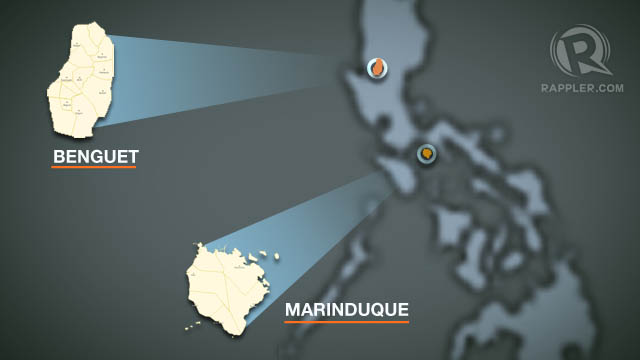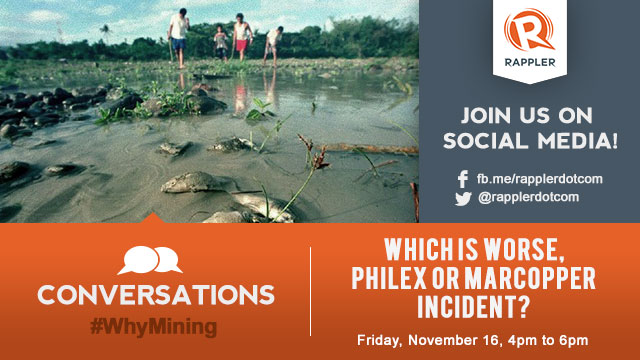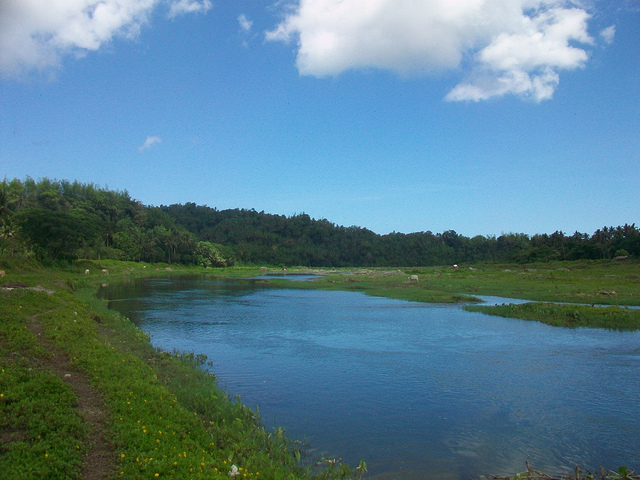SUMMARY
This is AI generated summarization, which may have errors. For context, always refer to the full article.

MANILA, Philippines – Which is worse, the 2012 Philex Mining spill in Benguet mining province or the 1996 Marcopper spill in Marinduque? Which host communities incurred more damage and to what extent? What are the mistakes of the mining companies and were they negligent? What are the remediation efforts done and are they enough? Ultimately, who’s more responsible?
These issues were debated during the November 16 series of the Rappler-hosted #WhyMining conversation on Twitter.
Representatives from business, industry, environment, non-government groups and active netizens engaged in a two-hour discussion from 4pm to 6pm, pointed fingers, stressed their own position and shared their experiences regarding mining disasters.
The tailings pond spills at the mines of Philex and Marcopper have haunted the industry already facing stiff opposition from various groups. The description of Philex’s Padcal incident as the ‘biggest mining disaster in the Philippines’ by the Mines and Geosciences Bureau of the Department of Environment and Natural Resources (DENR-MGB) triggered this Twitter conversation topic.

Personal experiences
While the Padcal incident is considered the worst in the industry in terms of volume of discharge to the nearby water systems, the Marcopper disaster is still considered by some environment groups as the worst due to toxicity and damage.
Early into the onbline discussion, those who have personal experiences and industry insight regarding the Marcopper disaster, which persists up to now, immediately jumped in.
Reports of health diseases are still frequent in the communities affected by the 1996 incident. @WebStalker, an active netizen and participant in the #WhyMining conversation, shared personal experiences regarding the effects of the incident saying some of the residents died of health causes particularly of tuberculosis.
@lean_santos_ until now my relatives are suffering from its effect.#WhyMining
— WebStalker® (@WebStalker) November 16, 2012
@lean_santos_ most of them died from tuberculosis,etc.mostly health related.unexplained weight loss.until now.#WhyMining
— WebStalker® (@WebStalker) November 16, 2012
Chikka Asia, Inc. corporate communications director Junie Agcaoili (@junieagcaoili) said that the Marcopper incident is a ‘landmark’ incident and is even declared by the United Nations as an ‘environmental disaster’.
@johnallanegui @lean_santos_ @calvinsantos1 Agree MARCOPPER is a landmark — the UN declared it an environmental disaster #whymining
— Junie Agcaoili (@junieagcaoili) November 16, 2012
To counter these sentiments, responsible mining advocate Rex Singson (@RexSingson) shared to Rappler a recent photo of the Boac River, pointing out the vibrance of the Boac River that is frequently reported as already “dead” following the mining disaster.
#whymining This is the Boac River today. Doesn’t look “biologically dead” to me!: flic.kr/p/9JAZ37
— Rex Singson (@RexSingson) November 16, 2012

However, Philippine District Manager of Al Gore’s The Climate Reality Project Rod Galicha (@kalikasan101), argued that it is Mogpog River that’s declared dead and not the Boac River. He also reiterated that comparing the two in terms of toxicity would be defeatist as both incidents are still disasters and caused damage to the environment and the surrounding communities. The spills, whether toxic or not, are still wastes according to him.
#WhyMining Marinduque toxic, Padcal non-toxic? True, but the same – all waste elements! Spell W-A-S-T-E.
— Rod Galicha (@kalikasan101) November 16, 2012
Comparing damage, communities affected
Some of the points of comparison for the Philex and Marcopper incidents include the volume of the spill, damage to the environment and surrounding communities as well as the remediation efforts done by the mining companies responsible.
Issues of the fairness of comparing Philex to Marcopper are prominent in the Twitter-based discussion.
Mining engineer Jan Carlo Parian (@JCParian), however, pointed out that such comparison is unfair saying Marcopper’s damages were more ‘catastrophic’ than that of Philex.
@lean_santos_ in the Philex incident. Marcopper’s damages are way more catastrophic. It is UNFAIR to Philex to be compared to Marcopper.
— JC Parian (@jcparian) November 16, 2012
He added that the only thing that makes Philex’s incident worse than Marcopper was the volume of the wastes spilled and not the toxicity level.
Philex = non-toxic, Marcopper = toxic #WhyMining
— JC Parian (@jcparian) November 16, 2012
@lean_santos_ The volume of tailings from the Philex incident maybe greater but it is “Non-toxic”. Marcopper leaked 2-3 million metric tons
— JC Parian (@jcparian) November 16, 2012
@lean_santos_ of “Toxic” tails and we all witnessed its severe damages to the people and the environment. These damages cannot be observed
— JC Parian (@jcparian) November 16, 2012
The Philex’s Padcal incident saw 20.69 million metric tons of mine wastes spilled to Balog Creek while Marcopper saw 2 million to 3 million metric tons of waste spilled to the Boac River. However, the magnitude of the effect of Marcopper in its surroundng communities was worse since the about 20,000 villagers in the island in Marinduque were affected. In Padcal, 42 communities were hit.
Jerome Oraiz (@_lom), a professor, stressed, however, that the magnitude of the damage of the two disasters are different but they both are destructive to the environment.
marcopper & philex are of different level of damage yet the effect all go to the environment,.not much of a difference #WhyMining
— jerome oraiz (@lom_) November 16, 2012
@junieagcaoili theres no doubt about the huge damage marcopper had,.,the fact that both of them incurred damages #WhyMining
— jerome oraiz (@lom_) November 16, 2012
Social scientist John Allanegui (@JohnAllanegui) said no compensation is enough for the long-term damages on the environment and in the surrounding communities. He said that community relations have also been affected and this is much more severe and more difficult to repair.
To some extent, no. Damage has become irreversible in the mind of the public. Community dynamics have been severed. #WhyMining @lean_santos_
— JP Allanegui (@JohnAllanegui) November 16, 2012
Netizen Anthony Patrick Chua agreed to this saying the damage to nature is impossible to repair completely and companies should mitigate plans and efforts that would incur the least damage and most sustainable outcome.
@lean_santos_ It will never be enough. Nature is irreplaceable. But it must approximate the least damage and the most sustainable outcome.
— Anthony Patrick Chua (@An2nyPa3ck) November 16, 2012
Be proactive
One of the hottest topic during the Twitter conversation was the attitude of the mining companies in anticipating such incidents. Prominent in the recent Padcal incident is the debate on whether the spill was caused by negligence or force majeure. This is also the point of contention of Philex regarding the P1-billion fine that the Mines and Geosciences Bureau have imposed on them on top of other fines due to environmental violations.
Force majeure, according to Section 3 clause (s) of the Philippine Mining Act of 1995 (R.A. 7942), is defined as ‘acts or circumstances beyond the reasonable control of contractor.‘ These include natural disasters or ‘act of God’ like typhoons, floods and earthquakes among others.
Rod Galicha (@kalikasan101) argued that ‘force majeure’ is unacceptable as companies should have standards that accommodate extreme weather conditions as climate change has been a prevalent issue debated on as early as the 1990s. He also added that, for responsible mining to happen, a climate change adaptation plan coupled with advance technology is necessary so as to prevent these incidents to happen.
@calvinsantos1 extrme weather/climate change discussed in 90’s, dam made 1991, in 20 years no consideration of extreme weather?
— Rod Galicha (@kalikasan101) November 16, 2012
@junieagcaoili @lean_santos_ Dam good for 20 years. So it means Philex has no framework on extreme weather conditions?
— Rod Galicha (@kalikasan101) November 16, 2012
@junieagcaoili #WhyMining @lean_santos_ Responsible Mining = Advnced Tech & Mainstreaming Climate Change Adaptation/Mitigation: Why a spill?
— Rod Galicha (@kalikasan101) November 16, 2012
This brought the discussion to whether the standards and regulatory measures in place already take into account extreme weather conditions that hit different parts of the country, including the mine sites.
The discussion flowed toward this question: Is it the fault of the mining companies if they did not including climate change adaptation strategies in their plans, or is it the government for implementing standards that are not anticipatory of natural calamities, including heavy rainfall that preceeded both tailing ponds leaks?
This was reiterated by Computer analyst Mali Cabrera. He said that these companies already operating mining sites have government approved standards. If these standards fail, it is the government’s responsibility and not the companies’.
@kalikasan101 @lean_santos_ @lom_ All mining co hs govt approved standards. If that standrd fails, dnt go aftr mining co. go after the govt.
— Mali Cabrera (@mcabrareman) November 16, 2012
Remediation efforts
One of the glaring differences of Philex and Marcopper discussed in the conversation is the attitude of the mining companies in taking reponsiblity immediately after the mining spill, and the remediation efforts taken afterwards.
Philex immediately admitted responsibility and communicated to stakeholders the financial impact and clean-up efforts being done while Marcopper took no immediate action due to lack of finances.
Philex is currently implementing an Integrated River Basin Rehabilitation and Management (IRBM) plan on top of monetary assistance given to local residents amounting to P800,000 for loss of livelihood. Marcopper’s Canadian partner, Placer Dome, have paid P38.5-million to 5,318 affected residents through the Environmental Guarantee Fund (EGF) over the past 16 years. About 5,242 more have not been given compensation amounting to P64-million as the residents don’t want to give up the right to hold the mining firms accountable.
Junie Agcaoili stressed this difference saying that Philex have been more responsible in owning the responsibility of the incident.
@lean_santos_ @lom_ Marcopper left Boac dead. Floods destroyed community. Philex contained +clean up underway. Fish safe to eat #whymining
— Junie Agcaoili (@junieagcaoili) November 16, 2012
Discussions about legal cases meant hold the mining firms accountable was also aplenty.
Philex, despite the magnitude of the volume of the spill, has so far been spared from lawsuit cases from local communities, aside from the fine imposed by the government. Marcopper, on the other hand, still face decade-old lawsuit cases particularly a P41-million case filed by Mogpog residents as well as a P49.2-billion class suit filed by the Calancan Bay Fisherfolk Federation (CBFF). Both cases are still not resolved up to this day.
Asked about this lopsided comparison, Mali Cabrera, highlighted Philex’s transparency and readiness to admit responsbility that made it different with Marcopper.
@lean_santos_ Because Philex has been transparent while Marcopper has been evil all this time to this day. Marcopper deserves it.
— Mali Cabrera (@mcabrareman) November 16, 2012
– Rappler.com
Add a comment
How does this make you feel?
There are no comments yet. Add your comment to start the conversation.